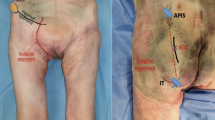Summary
Colored gelatin was selectively injected into the branches of the lateral circumflex femoral artery of fetal and adult cadavers, as well as into the popliteal artery of fetuses. Using this technique, it can be shown that the distal third of the lateral thigh skin has a multi-arterial supply. When a musculocutaneous tensor fascia lata flap with a distal extension is elevated, its medial, lateral and distal arterial input is cut off, transforming its skin paddle into a skin flap with a random blood supply. In order to avoid skin necrosis, a delay three weeks prior to the definitive elevation of the flap is recommended. The delay procedure preserves the vascular supply of the skin paddle coming from the superior lateral geniculate artery and the tensor fascia lata artery, establishing an ‘axial’ pattern of vascularization, thereby enhancing flap survival.
Similar content being viewed by others
References
Baek S-M (1983) Two new cutaneous free flaps: the medial and lateral thigh flaps. Plast Reconstr Surg 71:354
Bostwick J, Hill L, Nahai F (1978) Repairs in the lower abdomen, groin or perineum with myocutaneous or omental flaps. Plast Reconstr Surg 63:186
Botta Y, Krupp S: Unpublished data
Cormarck GC, Lamberty BGH (1985) The blood supply of thigh skin. Plast Reconstr Surg 75:342
Dibbell DG, McCraw JB, Edstrom LE (1979) Providing useful and protective sensibility of sitting area in patients with meningo myelocele. Plast Reconstr Surg 64:796
Grabb WC, Myers MB (1975) Skin flaps. Little, Brown and Co, Boston
Gray's Anatomy (1975) Lea and Feabiger, Philadelphia
Hill L, Nahai F, Vasconez LO (1978) The tensor fascia lata myocutaneous free flap. Plast Reconstr Surg 61:517
Hollinshead WH (1954) Anatomy for surgeons, Vol 3. Hoeber-Harper, New York, pp 698
Katsaros J (1982) Use of the island tensor fasciae latae flap to cover a chest-wall defect. Plast Reconstr Surg 69:1007
Krupp S, Milliet AC (1982) Why and when to delay TFL flaps. Chir Plastica 7:23
Krupp S, Kuhn WK, Zaech GA (1982) Le lambeau sensible du tenseur du fascia lata. Helv Chir Acta 49:217
Krupp S, Zaech G (1976) Operative treatment of pressure sores in paraplegics by rotation flap. Paraplegia 14:29
Krupp S, Kuhn W, Zaech G (1983). The use of innervated flaps for the closure of ischial pressure sores. Paraplegia 21:119
Krupp S (1986) De l'importance du lambeau myocutané en chirurgie générale. Rev Méd Suisse Romande 106:619
McGregor IA, Morgan G (1973) Axial and random pattern flaps. Br J Plast Surg 26:202
Manchot C (1889) Die Hautarterien des menschlichen Körpers. Vogel, Leipzig
Mathes SJ, Nahai F (1979) Clinical atlas of muscle and musculocutaneous flaps. Mosby, St Louis
Myers B (1987) Understanding flaps necrosis. Plast Reconstr Surg 78:813
Nahai F, Silverton J, Hill L, Vasconez L (1978) Tensor fascia lata musculocutaneous flap. Ann Plast Surg 1:372
Nahai F, Hill L, Roderick H (1979) Experiences with the tensor fascia lata flap. Plast Reconstr Surg 63:788
Nakayama Y, Soeda S, Kasai Y (1982) The importance of arterial inflow in the distal side of a flap: an experimental investigation. Plast Reconstr Surg 69:61
Nakajima H, Maruyama Y, Koda E (1981) The definition of vascular skin territories with prostaglandin E1 — the anterior chest, abdomen and thigh-inguinal region. Br J Plast Surg 34:258
Rouviere H (1970) Précis d'anatomie humaine. Masson, Paris
Salmon M (1936) Artères de la peau. Masson, Paris
Song YG, Chen GZ, Song YL (1984) The free thigh flap: a new free flap concept based on the septocutaneous artery. Br J Plast Surg 37:149
Souyris F, Gary-Bobo A, Reynaud JP, Charissoux G (1980) Lambeau myocutané du tenseur du fascia lata. Mise au point anatomiques et techniques. Ann Chir Plast 25:159
Wexler R (1987) Personal communication. 14th Alpine Workshop, Champfer
Withers EH, Francklin JD, Madden JJ, Lynch JB (1980) Further experience with the tensor fascia lata musculocutaneous flap. Ann Chir Plast 4:31
Author information
Authors and Affiliations
Rights and permissions
About this article
Cite this article
Zufferey, J., Doerfl, J. & Krupp, S. The anatomical basis for delaying the musculocutaneous tensor fascia lata flap with a distal extension. Eur J Plast Surg 11, 109–116 (1988). https://doi.org/10.1007/BF00539270
Issue Date:
DOI: https://doi.org/10.1007/BF00539270




